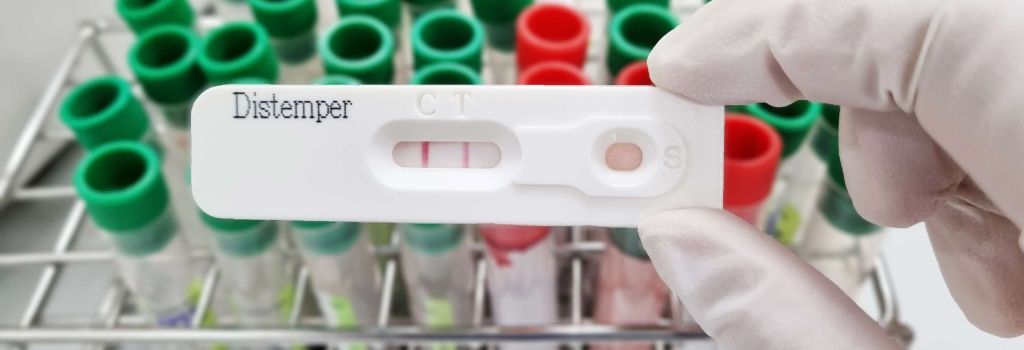Vaccines have saved more lives than any other medical advancement. However, there has been a recent pushback in human and animal vaccine acceptance – known as “vaccine hesitancy.” This term refers to the reluctance or refusal to vaccinate despite the availability of vaccines. In fact, according to research from Boston University, nearly “40% of respondents believed that canine vaccines are unsafe, more than 20% believed these vaccines are ineffective, and 30% considered them to be medically unnecessary.”
Vaccines are one of the strongest medications our dogs (or cats or us) can receive. They should be selected carefully with appropriate timing to receive the greatest benefit and minimize risks. Understanding how vaccines work is essential in this process.
It is important to know what vaccines can do and what they cannot do – in other words, how the immune system works and responds to vaccines. You also need to know how vaccines work, which vaccines are appropriate for your pet’s lifestyle, how to select the right vaccines, and how vaccines should be handled and administered. Vaccines are one of many important components in preventing infectious disease, and with vaccine hesitancy growing in many communities – including the pet owner community – it’s more important than ever for pet owners to understand vaccinology and the reasoning behind the recommendations and plans veterinarians create for our pets.
The 4 Types of Veterinary Vaccines
There are four general kinds of vaccines: modified live (attenuated), inactivated (killed), recombinant immunizing agents, and toxoid.
- In a modified live vaccine, the disease-causing organism is altered and weakened so it can be administered to a patient, creating an immune response but not causing disease.
- A killed vaccine contains only bacteria or viruses that are dead, allowing the immune system to see and create immunity but not cause disease.
- Recombinant agents are made of a live attenuated (weakened) viral or bacterial strain used as a vector to carry the gene or genes encoding the desired vaccine antigens.
- Toxoids protect against the toxin produced by the offending bacteria.
One final way to classify vaccines is whether they are to protect against viral diseases or bacterial diseases, called bacterins.

Tools for Determining the Best Vaccination Schedule for Dogs & Puppies
Puppies are born with a "naive" immune system, meaning they have little immunity to viruses and bacteria. Their initial immunity comes from their mother's colostrum, which they need to receive within the first 24 hours. If they don’t get enough colostrum, they risk "failure of passive immunity," making them vulnerable to illness. If necessary, colostrum, plasma, or serum from donor dogs can be administered to boost immunity. Excess colostrum can be collected and stored for up to a year. Plasma or serum can be sourced from a healthy, hyperimmunized dog. The standard dose for plasma is 16 cc per pup and can be given via feeding tube, subcutaneously, or intravenously within 24 hours of thawing.
Pups that have received adequate amounts of colostrum when under 24 hours old will have immunity to what their mothers are immune to – this is called “passive” immunity. As pups mature, the maternal antibodies slowly degrade. As the antibodies drop, the pup’s immune system can begin to mount its own response – this is called “active” immunity.
The challenge in vaccinating puppies is timing the administration so their immune systems can produce antibodies before exposure to serious diseases. Dr. Ron Schulz and Dr. Laurie Larsen created a nomogram to help determine this timing. A puppy’s immunity decreases by 50% every two weeks from birth, and higher maternal antibodies prolong immunity, delaying vaccination. Since blood testing every puppy isn’t practical, a series of vaccinations is typically administered to increase the chances that maternal antibodies will want and allow the puppy to develop active immunity.
Titers & Nomograms
Some breeders prefer to use a nomogram to give a series of vaccines to their pups. The advantage of using a nomogram is that the pups can receive fewer vaccines, reducing potential adverse reactions to “too many” vaccines. The disadvantages are the cost of the test and that you are assuming that all the pups in the litter received the same amount of colostrum and were able to absorb it. The reality is that not all pups in all litters receive protective amounts of colostrum. This can occur if a pup is weak and an ineffective nurser if the pup is pushed off a good spot at the nursing bar, if the pup is born late in a large litter and misses out on the good stuff, and so on.
The cost is usually under $200 to test the dam. Should you decide to do a nomogram, the blood should not be collected in the two weeks prior to or just after whelping as the antibodies in the blood at this time will be artificially low, because they were all sequestered in the mammary glands for the pups.
The University of Wisconsin Veterinary Immunology Department CAVID lab is where we recommend you submit samples for titers. You can complete your submission using this form.
Veterinary & Health History
This may seem simple, but your puppy’s veterinary and health history are crucial elements that can help determine the best and most effective vaccination schedule for your puppy. Some health complications or illnesses can change what your veterinarian would recommend for dog vaccines, so it’s important to work closely with them to ensure your dog’s age, health, and lifestyle are taken into account when creating a vaccination plan.
For example, there are times when vaccines may not be a good idea for your dog, either temporarily or permanently. Temporary pauses would include pregnancy, short-term medication use, or illnesses. Permanent pauses would include patients suffering from immune-mediated diseases such as Auto-immune hemolytic anemia or thrombocytopenia, sterile meningitis, lupus, and immune-mediated polyarthritis. Be sure to give a complete medical history prior to anyone administering vaccines to your dog.
Remember, vaccines are one of the strongest medications you can give to your dog. Avoid low-cost vaccine clinics, going to a veterinary clinic that does not know or have your dog’s entire medical history, or “do it yourself” vaccines if your dog has any medical condition that could put them at risk of an adverse vaccine reaction.
How Many Vaccines Do Puppies Need?
Puppies need a series of vaccines when young to mount an adequate protective vaccine response. Since most of us don’t do titers on each pup in the litter, we need to repeatedly expose the pups to the antigens, the proteins that allow the immune system to develop antibodies. By starting to vaccinate between 6 and 8 weeks of age, and repeatedly administering vaccines till the pups are 18 to 20 weeks old, we can give our pups protection. Somewhere in the 6-week to 20-week age range, almost every pup will have their maternal antibodies bottom out and be exposed to the vaccine antigens, producing their own active immunity. If you start vaccinating too late or stop too early, you are putting your pups at risk of being exposed to a disease they are not prepared to fight off.

Why Dogs Need Boosters
Over time, even pups with competent immune systems will have their antibody levels wane. For this reason, we need to booster our adult dogs. In general, we booster young adults approximately one year after they complete their vaccine series for appropriate lifestyle and core-based diseases. After the 15-month age, we booster for some diseases annually and tri-annually. In general, bacterial diseases need annual boosters (Leptospirosis, Lyme disease, Bordetella), and viral diseases need tri-annual boosters (Rabies, Distemper, Adenovirus, Parvovirus, Parainfluenza virus). Distemper, Parvovirus, and Adenovirus are the only viral diseases routinely titered for in dogs. The Leptospirosis test is used to diagnose exposure to the disease, not to determine if a booster vaccine is indicated.
What Happens If You Don’t Vaccinate Your Dog?
When puppies aren’t vaccinated, or miss key, core vaccinations, they become vulnerable to a number of diseases that are completely preventable.
In addition to the health consequences for your puppy, you, as the owner, could also be on the hook for legal consequences in your area if you fail to administer certain vaccinations to your pup. For example, most states have requirements in place for all pets to regularly receive a rabies vaccination and register with the state. Failing to comply could result in fines and other penalties.
Vaccination Failures: When Things Don’t Go According to Plan
Most pups will mount an adequate immune response to a series of 2 vaccines administered 2 to 4 weeks apart. The 1st vaccination a pup or adult dog receives will allow the pup’s immune system to see a foreign protein and start the formation of antibodies. The 2nd and additional vaccines, or boosters, will create a stronger immune response, called an anamnestic response. Patients with a healthy immune system will have a memory of these vaccines, sometimes lasting a lifetime.
It is important to understand that administering the booster in less than 14 days from the 1st vaccination can do more harm than good. The immune system needs at least 2 weeks to respond to an additional vaccine. Administering a booster in less time can suppress the immune system. Keep good records and work with veterinary professionals who follow these guidelines.
After the 1st series of Distemper and Parvovirus vaccines are administered, you can assess the pup’s response to the vaccine by following the last vaccine with a blood test called a titer. A nomogram is a titer interpreted for use to predict when pups will respond to their 1st vaccines for Distemper, Parvovirus, and Adenovirus. A titer is the same blood test but used to assess an individual dog’s response to these vaccines.
Some breeds and some individuals within a breed (up to 10%) may not respond adequately to a vaccine. These include Rottweilers, Dobermans, and some of the Bullie Breeds. Knowing this failure to respond to vaccines will allow the owners to request additional vaccines be administered to these patients. Often, changing the manufacturer of the vaccine and repeating the titer will allow for these low or no-responders to safely interact with other dogs. Should you have a dog or line of dogs who do not adequately respond to vaccines, you need to be extra vigilant to protect these dogs.
Although titers can be run to assess vaccine responses to rabies vaccines, most states and municipalities will not accept a protective titer as an alternative to rabies vaccines. While it is possible that many dogs have protection for longer than 3 years, the 3-year interval is still required to have a dog considered vaccinated. Only in rare circumstances would it be recommended that you use a titer as an alternative to triannual rabies boosters. Don’t take a chance. Rabies vaccines for our dogs are as much for protecting human health as for canine health.
Working With Your Veterinarian to Make Dog Vaccinations Make Sense
Vaccinating your dog is one of the most effective strategies for ensuring a long and healthy life while simultaneously safeguarding the wider community of pets and humans. Although vaccine schedules and types may at first be confusing or difficult to understand, working closely with your dog's veterinarian to develop a customized vaccination plan that considers your dog's age, lifestyle, and health status is the best course of action for safeguarding your dog against preventable disease. As with any medical treatments and preventatives, there can be side effects associated with dog vaccinations; however, they are typically uncommon, and the protective advantages of vaccinations significantly surpass these potential risks.
Taking a proactive role in your dog's preventive care through vaccinations not only reduces the chance of disease but also contributes to a healthy pet population -- which is a good thing for everyone.
But this isn't everything a dog owner needs in order to properly navigate the world of pet vaccinations. In the next part of our series on pet vaccinations, we're covering vaccination schedules and the differences between core and non-core vaccinations to help you understand what vaccinations your dog really needs, and when they need to get them.
If you have questions and you'd like to reach out to us, you can call us directly at (212) 288-8387, or you can email us at [email protected]. Don't forget to follow us on social media Facebook, Instagram.

